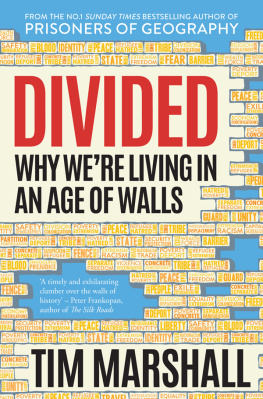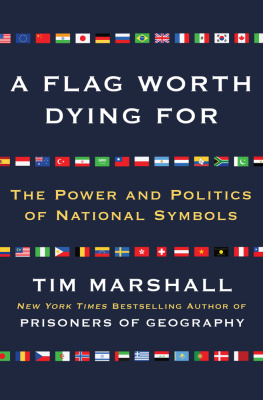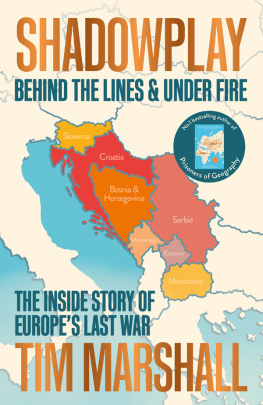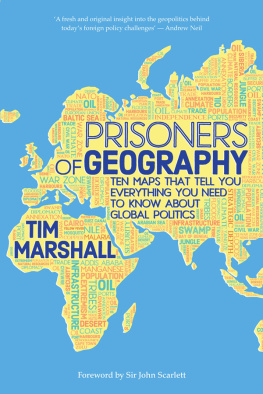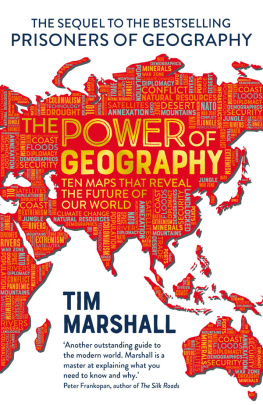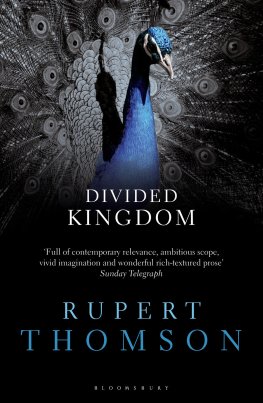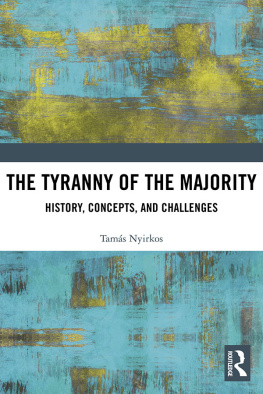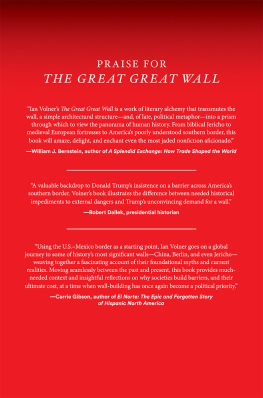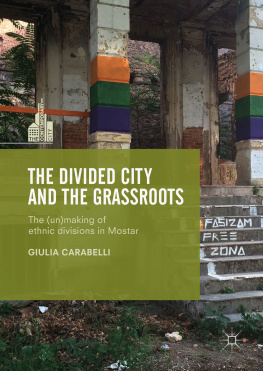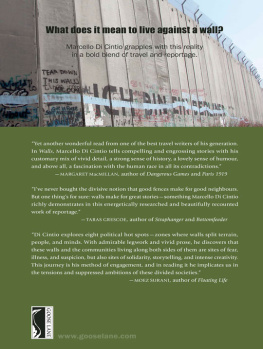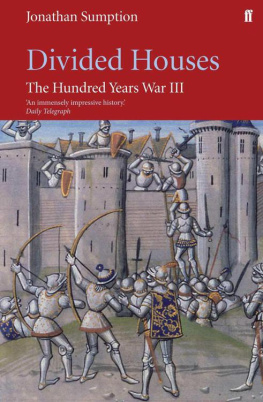Contents
Guide
INTRODUCTION
T HE BORDER WALL BETWEEN ISRAEL AND THE WEST BANK IS among the most forbidding and hostile in the world. Viewed from up close, whichever side you find yourself on, it rears up from the ground, overwhelming and dominating you. Faced by this blank expanse of steel and concrete, you are dwarfed not only by its size but by what it represents. You are on one side; they are on the other.
Thirty years ago a wall came down, ushering in what looked like a new era of openness and internationalism. In 1987 President Ronald Reagan went to the Brandenburg Gate in divided Berlin and called out to his opposite number in the Soviet Union, Mr Gorbachev tear down this wall! Two years later it fell. Berlin, Germany and then Europe were united once more. They were heady times in which some intellectuals predicted an end of history. However, history does not end.
In recent years, the cry Tear down this wall is losing the argument against fortress mentality. It is struggling to be heard, unable to compete with the frightening heights of mass migration, the backlash against globalization, the resurgence of nationalism, the collapse of Communism and the 9/11 attacks and their aftermath. These are the fault lines that will shape our world for years to come.
We are seeing walls being built along borders everywhere. Despite globalization and advances in technology, we seem to be feeling more divided than ever. Thousands of miles of walls and fences have gone up around the world in the twenty-first century. At least sixty-five countries, more than a third of the worlds nation states, have built barriers along their borders; half of those erected since the Second World War sprang up between 2000 and now. Within a few years, the European nations could have more miles of walls, fences and barriers on their borders than there were at the height of the Cold War. They began by separating Greece and Macedonia, Macedonia and Serbia, and Serbia and Hungary, and, as we became less shocked by each stretch of barbed wire, others followed suit Slovenia began building on the Croatian border, the Austrians fenced off Slovenia, Sweden put up barriers to prevent illegal immigrants crossing from Denmark, while Estonia, Latvia and Lithuania have all started defensive fortifications on their borders with Russia.
Europe is certainly not alone: the United Arab Emirates has built a fence along the border with Oman, Kuwait likewise with Iraq. Iraq and Iran maintain a physical divide, as do Iran and Pakistan all 435 miles of it. In Central Asia Uzbekistan, despite being landlocked, has closed itself off from its five neighbours, Afghanistan, Tajikistan, Kazakhstan, Turkmenistan and Kyrgyzstan. The border with Tajikistan is even mined. And on the story goes, through the barriers separating Brunei and Malaysia, Malaysia and Thailand, Pakistan and India, India and Bangladesh, China and North Korea, North and South Korea and so on around the world.
There are many reasons why we erect walls, because we are divided in many ways in terms of wealth, race, religion and politics. Sometimes divisions lead to violence, and walls are erected to protect or defend. Sometimes walls go up to keep certain people out. Sometimes physical walls dont go up at all, but we still feel the separation; its in our minds. These invisible barriers are often just as effective.
These walls tell us much about international politics, but the anxieties they represent transcend the nation-state boundaries on which they sit. The primary purpose of the walls appearing throughout Europe is to stop the wave of migrants but they also say much about wider divisions and instability in the very structure of the European Union, and within its member nations. President Trumps proposed wall along the USMexico border is intended to stem the flow of migrants from the south, but it also taps into a wider fear many of its supporters feel about changing demographics.
Division shapes politics at every level the personal, local, national and international. Its essential to be aware of what has divided us, and what continues to do so, in order to understand whats going on in the world today.

Picture the beginning of Stanley Kubricks 1968 sci-fi masterpiece 2001: A Space Odyssey, in the sequence titled The Dawn of Man. On the African Savannah in prehistoric times, a small tribe of proto-man/ apes is drinking peacefully at a watering hole when another tribe turns up. The individuals are quite happy to share with their own group but not with this new other tribe. A shrieking match ensues in which the new group succeeds in taking over the watering hole, forcing the others to retreat. At this point, if the newcomers had had the nous to make a few bricks and mix some cement they could have walled off their new possession and guarded it. But, given that this is set a few million years ago, they have to fight it out again when the first tribe returns some days later, having boned up on warfare, to reclaim its territory.
Grouping into tribes, feeling alarmed by a lot of outsiders and responding to perceived threats are very human things to do. We form ties that are important for survival, but also for social cohesion. We develop a group identity, and this often leads to conflict with others. Our groups are competing for resources, but there is also an element of identity conflict a narrative of us and them.
In the early history of mankind, we were hunter-gatherers: we had not settled, or acquired permanent fixed resources that others might covet. Then, in parts of what we now call Turkey and the Middle East, humans started farming. Instead of roaming far and wide to find food, or graze livestock, they ploughed the fields and waited for the results. Suddenly (in the context of evolution) more and more of us needed to build barriers: walls and roofs to house ourselves and our livestock, fences to mark our territory, fortresses to retreat to if the territory was overrun, and guards to protect the new system. The age of walls was upon us and has gripped our imagination ever since. We still tell each other tales of the walls of Troy, Jericho, Babylon, the Great Wall of China, Great Zimbabwe, Hadrians Wall, the Inca Walls in Peru, Constantinople and many others. On and on they stretch, through time, region and culture, to the present but now they are electrified, topped with searchlights and CCTV.
These physical divisions are mirrored by those in the mind the great ideas that have guided our civilizations and given us identity and a sense of belonging such as the Great Schism of Christianity, the split of Islam into Sunni and Shia, and in more recent history the battles between Communism, Fascism and Democracy.
The title of Thomas Friedmans 2005 book The World is Flat was based on the belief that globalization would inevitably bring us closer together. It has done that, but it has also inspired us to build barriers. When faced with perceived threats the financial crisis, terrorism, violent conflict, refugees and immigration, the increasing gap between rich and poor people cling more tightly to their groups. The co-founder of Facebook, Mark Zuckerberg, believed social media would unite us. In some respects it has, but it has simultaneously given voice and organizational ability to new cyber tribes, some of whom spend their time spewing invective and division across the World Wide Web. There seem now to be as many tribes, and as much conflict between them, as there has ever been. The question we face today is: what form do our modern tribes take? Do we define ourselves by class, by race, by religion, by nationality? And is it possible for these tribes to coexist in a world where the concept of us and them remains?

